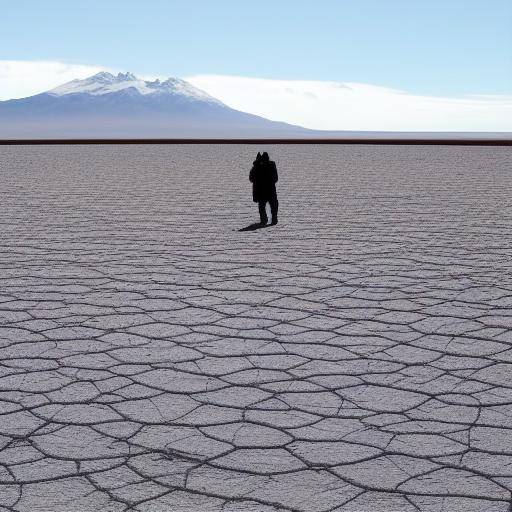
Introduction
The Salar de Uyuni, located in Bolivia, is the world's largest continuous salt desert and a fascinating destination that hosts stunning natural formations that challenge reality. In this guide, you will immerse yourself in the majesty of this unique place, exploring the 10 most extraordinary salt formations that will make you maravilles to the grandeur of nature.
History and Background
The Salar of Uyuni, with its vast expanse of white salt like snow, was formed from prehistoric lakes that evaporated, leaving behind this natural wonder. Since ancient times, this place has been fundamental to the local population, playing important cultural, economic and tourist roles.
In this context, the impressive salt formations such as the "Infinite mirror" have attracted the attention of travelers from around the world, becoming an iconic symbol of natural beauty in its purest state.
Infinite Mirror: A Unparalleled Spectacle
The "Infinite Specicle", known in Spanish as the "Salar de Uyuni reflecting the sky", is a salt formation that gives the impression of a giant mirror during the rainy season. This natural phenomenon creates an impressive visual effect that challenges perception, making the landscape an almost unreal image where the horizon merges with the sky into a game of lights and colors.
This wonderful phenomenon attracts photographers, adventurers and nature lovers, providing the opportunity to capture unique and spectacular images that seem to come out of a dream. The sensation of walking on a sea of stars reflected in the salt is an experience that leaves an imprint on the memory of those who have the privilege to witness it.
Cactus Islands: Oases in a Salt Sea
The "Cactus Island" emerge as an oasis in the midst of the dazzling white landscape of the Uyuni Salar. These islands are adorned by giant cactus that reach impressive heights, creating a surprising contrast between the intense green of the vegetation and the bright white that surrounds it. These cactus, which have prospered in this unique environment over the centuries, have become a symbol of the resilience and beauty of nature.
Exploring these islands immerses you in a surreal world that makes you question the conventional laws of nature. The combination of exuberant life in the middle of a salt sea creates an experience that challenges logic and leaves an indelible impression on all who have the opportunity to visit them.
Flamenco Roses: Elegant Salars
The pink flamingos, beautiful inhabitants of the Salar de Uyuni, add a touch of grace and beauty to this unique landscape. These majestic birds, with their vibrant pink plumage, take refuge in the shallow lagoons that puncture the salt flat, creating an unforgettable contrast image between the pure white of the salt and the intense pink of these elegant birds.
The presence of pink flamingos adds an element of delicacy and harmony to this dazzling scenario, reminding us of the diversity and wealth of life that finds a home even in the most extreme environments. The opportunity to witness these majestic creatures in their natural habitat is an experience that connects with the deepest of our being.
Conclusion
The Salar de Uyuni is a natural treasure that houses salt formations that challenge our perception of reality and transport us to a world of surreal beauty. From the magical mirror that reflects the sky to the cactus islands and the pink flamingos that decorate this vast landscape, each formation offers a unique and unforgettable experience. The immensity of the Uyuni Salar and its salt formations continue to amaze those who have the privilege to witness them, highlighting the magnificentness and amazing ability of nature to challenge and captivate our perception.
Come and immerse yourself in this world of natural wonders that challenge reality, causing a wonder that will endure in your memory long after leaving this incredible place.
Frequently asked questions
1. What is the best time to witness the infinite mirror effect in the Uyuni Salar?
The infinite mirror effect occurs during the rainy season, usually between January and March, when the salt plain becomes a natural mirror due to the accumulation of a thin layer of water.
2. What additional attractions does the Uyuni Salar offer besides the infinite mirror?
In addition to the infinity mirror, the Salar de Uyuni houses the cactus islands, stunning colored lagoons and a rich wildlife, including pink flamingos.
3. What is the approximate height of cactus on the cactus islands?
Cactus on the cactus islands can measure up to 12 meters high, offering an impressive view and a unique visual contrast with the environment.
4. Why do pink flamingos choose the Salar de Uyuni as their habitat?
The pink flamingos are attracted by the shallow lagoons of the Salar de Uyuni, which provide them with a food-rich source and a favourable nesting environment.
5. Is the Uyuni Salar accessible to visitors all year round?
Yes, the Uyuni Salar is accessible throughout the year. However, the best time to visit and witness the most extraordinary phenomena is during the dry season (from May to October) or during the rainy season (from January to March).
6. What precautions should be taken when visiting the Uyuni Salar?
It is important to follow the recommendations of the tour guides, to bring sun protection, to properly hydrate and to take into account temperature variations, especially during the night.
In short, the Salar de Uyuni is a surreal destination that captivates those who visit him, presenting salt formations that challenge reality and transform a seemingly lifeless landscape into a scene of wonder and wonder. If you ever have the opportunity to witness these natural phenomena, do not hesitate to immerse yourself in the grandeur of this show that challenges all logic and connects you with the deepest essence of nature.
